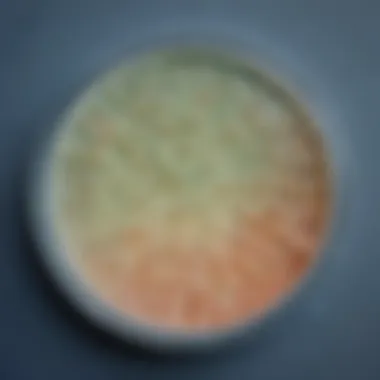Unlocking the Mysteries: The Crucial Role of Agar in Bacterial Growth Studies


Science Fun Facts
Agar, a jelly-like substance derived from seaweed, plays a pivotal role in bacterial growth studies. Its use in scientific research is fundamental for cultivating and isolating bacteria in laboratory environments. This gel-like medium provides a solid platform for bacteria to thrive and is crucial for conducting accurate experiments in microbiology. Did you know that agar is extracted from specific types of seaweed, making it a natural and safe option for growing bacteria in controlled settings?
Discover the Wonders of Science
Exploring the properties and applications of agar offers a fascinating glimpse into the world of microbiology. With educational resources such as videos and animations, learners can observe firsthand how agar nourishes bacterial cultures. The real-life application of agar in scientific experiments underscores its significance as a versatile tool in microbiological studies.
Science Experiment Showcase
Embark on a journey to discover the practical uses of agar in cultivating bacteria through engaging experiments. Step-by-step instructions guide participants in setting up agar plates for bacterial growth, complete with a detailed list of materials and safety precautions. By conducting these experiments, individuals can gain hands-on experience in working with agar and develop a deeper understanding of its role in scientific research.
Introduction
In the realm of microbiology, the utilization of agar as a growth medium for bacteria stands as a critical cornerstone. This gel-like substance, derived from seaweed, plays a pivotal role in nurturing and isolating bacterial cultures within laboratory settings. The choice of agar as a growth medium is essential for researchers and students in the field, as it provides a solid foundation for conducting accurate experiments and advancing microbial studies. Understanding the properties, uses, and techniques associated with agar is fundamental for achieving reliable results in bacterial growth studies.
Definition of Agar
Agar, defined as a gelatinous substance obtained from marine algae, serves as a versatile material in laboratory settings. This unique compound, when solidified, acts as a supportive base for bacterial proliferation and experimentation. Its ability to form a solid gel at room temperature makes it a valuable tool in microbiological studies, allowing researchers to cultivate and observe various bacterial strains with precision. The definition of agar extends beyond a mere substance; it embodies a fundamental component that underpins the foundation of bacterial growth studies.
Historical Background
The historical underpinnings of agar trace back to ancient Asian cultures, where it was first recognized for its gelling properties and medicinal uses. In modern times, the adoption of agar in microbiology can be attributed to the pioneering work of scientists in the late 19th and early 20th centuries. The incorporation of agar into laboratory practices revolutionized the field of microbiology, enabling researchers to cultivate bacteria in a controlled environment effectively. Understanding the historical context of agar provides valuable insights into its evolution as a fundamental tool in bacterial growth studies.
Purpose of the Article
The primary purpose of this article is to offer a comprehensive guide on the role of agar in bacterial growth studies. By delving into the properties, uses, and techniques related to agar, this article aims to equip readers with a profound understanding of how agar facilitates bacterial cultivation and experimentation in laboratory settings. Through a detailed exploration of agar's functions and applications, readers will gain insights into its significance in microbiological research and the essential role it plays in advancing our understanding of bacterial behavior and growth patterns.


Properties of Agar
Agar plays a crucial role in bacterial growth studies, serving as a fundamental component in laboratory settings. Understanding the properties of agar is vital for ensuring the success and accuracy of microbiological experiments. By delving into the specific elements and benefits of agar, researchers can harness its full potential. The unique characteristics of agar contribute to its versatility and reliability in nurturing bacterial cultures.
Gel Formation
Agarose and Agaropectin Components
In the realm of agar properties, the Agarose and Agaropectin components stand out for their significance in gel formation. Agarose provides the structural framework for the gel, offering a stable matrix for bacterial growth. On the other hand, Agaropectin contributes to the flexibility and texture of the agar gel. The interplay between these components ensures the optimal environment for bacterial cultivation, making agar a popular choice in microbiology research. The distinct properties of Agarose and Agaropectin enhance the overall effectiveness of agar as a medium for studying bacterial growth.
Solidifying Temperature
The solidifying temperature of agar is a critical aspect that influences its utility in bacterial growth studies. This temperature determines the point at which the agar transitions from a liquid to a solid state, forming a gel suitable for bacterial culture. The controlled solidification process is essential for creating a consistent environment for microbial growth. The ability to adjust the solidifying temperature offers researchers flexibility in designing experiments and preparing agar plates with precision. By understanding the nuances of solidifying temperature, scientists can optimize agar utilization in microbiological research.
Uses of Agar in Bacterial Growth Studies
Agar plays a crucial role in bacterial growth studies by serving as a solid foundation for cultivating and isolating bacteria in laboratory settings. In microbiology, agar is widely used in preparing culture media, a nutrient-rich environment that supports the growth of various bacterial species for research and experimentation. The gel-like nature of agar provides a stable and suitable substrate for bacterial colonies to thrive and multiply. By carefully selecting and preparing agar-based media, researchers can create controlled environments to observe the behavior and characteristics of different bacterial strains. The use of agar in bacterial growth studies is essential for obtaining accurate and reproducible results in various microbiological experiments, ensuring the reliability of scientific findings.
Culture Media Preparation
In the context of bacterial growth studies, culture media preparation is a fundamental step that involves creating a nutrient-rich environment suitable for supporting the growth of bacteria. Agar is a key component in culture media formulation due to its solidifying properties, which help in maintaining the integrity and structure of the media. To prepare agar-based culture media, researchers must first dissolve agar powder in water and mix it with other nutrients such as sugars, salts, and amino acids to create a balanced nutritional composition. The mixture is then sterilized to eliminate any contaminants that may interfere with bacterial growth. Proper sterilization techniques and aseptic precautions are crucial to ensure the quality and purity of the culture media, preventing unwanted microbial contamination that could compromise the results of bacterial growth studies.
Antibiotic Susceptibility Testing
Antibiotic susceptibility testing is a critical aspect of bacterial growth studies that aims to evaluate the effectiveness of antibiotics against different bacterial strains. Agar-based methods, such as the disk diffusion assay, are commonly used to assess the sensitivity of bacteria to various antibiotics by monitoring the formation of clear zones around antibiotic-soaked disks on agar plates. These clear zones indicate the inhibition of bacterial growth in the presence of antibiotics, allowing researchers to determine the susceptibility of bacterial isolates to specific antimicrobial agents. By performing antibiotic susceptibility testing on agar plates, scientists can identify the most appropriate treatment options for bacterial infections and monitor the emergence of antibiotic-resistant strains, contributing to the effective management of infectious diseases.
Isolation of Bacterial Colonies
The isolation of bacterial colonies on agar plates is a fundamental technique in microbiology that enables researchers to obtain pure cultures of individual bacterial species for further analysis. By streaking a bacterial sample onto an agar plate and incubating it under suitable conditions, individual bacterial cells can form discrete colonies that are visible to the naked eye. These bacterial colonies contain genetically identical cells derived from a single progenitor, allowing for the study of microbial characteristics and behaviors at the cellular level. Isolating bacterial colonies on agar plates is essential for characterizing bacterial species, identifying pathogenic strains, and conducting microbial research with a high degree of precision and accuracy.


Agar Techniques in Microbiology
Agar techniques in microbiology play a crucial role in bacterial growth studies, forming the backbone of numerous laboratory experiments and procedures. Understanding the different agar techniques is essential for researchers in the field of microbiology to culture and study bacteria effectively. These techniques are not only practical but also offer specific advantages in terms of isolating and identifying bacteria in a controlled environment.
Streak Plate Method
The streak plate method is a fundamental technique used in microbiology to isolate pure bacterial cultures from a mix of different microorganisms. In this method, a sterile inoculating loop is used to streak the sample in a sequential pattern on an agar plate. Through successive dilutions, individual bacterial colonies can be separated and grown, allowing for the analysis of pure cultures. This method is invaluable for studying the characteristics and behaviors of specific bacterial strains in isolation.
Pour Plate Method
Contrasting the streak plate method, the pour plate method involves mixing the bacteria sample directly into the liquid agar before solidification. This technique allows for the even distribution of bacteria throughout the agar medium, promoting the growth of colonies both on the surface and within the agar. By pouring the mixture into a plate, researchers can observe bacterial growth patterns in three dimensions, facilitating the study of bacteria that require different oxygen levels for optimal growth.
Spread Plate Method
The spread plate method entails spreading the bacteria sample evenly over the surface of a solidified agar plate using a sterile glass rod or spreader. This technique is beneficial for achieving a uniform distribution of bacterial colonies across the agar surface, enabling researchers to count colony-forming units accurately and assess bacterial concentration. The spread plate method is particularly useful for quantifying bacterial populations and evaluating microbial contamination levels in various samples.
Factors Influencing Bacterial Growth on Agar
In the realm of microbiology, understanding the intricacies of Factors Influencing Bacterial Growth on Agar is paramount. These factors play a pivotal role in dictating the outcomes of bacterial studies conducted using agar as a growth medium. By delving into the nuances of temperature, incubation period, pH levels, and oxygen availability, researchers can optimize their experimental conditions for various microbial species. This section will shed light on the significance of these factors in influencing bacterial growth dynamics and outcomes within laboratory settings.
Temperature and Incubation Period
When considering the interplay between bacteria and agar, the Temperature and Incubation Period emerge as critical determinants of bacterial growth patterns. Temperature affects the rate of bacterial proliferation, with different species thriving at specific temperature ranges. Additionally, the incubation period determines the duration required for bacterial colonies to develop on agar plates. Maintaining precise temperature conditions and incubation periods is essential for fostering optimal growth conditions for diverse bacterial strains. This subsection will explore the nuanced relationship between temperature, incubation period, and bacterial cultivation, offering insights into best practices for achieving reliable results in microbiological experiments.
pH Level
Another fundamental aspect influencing bacterial growth on agar is the pH Level of the growth medium. Bacteria exhibit varying affinities towards different pH environments, with some species thriving in acidic conditions while others prefer alkaline settings. Ensuring the appropriate pH level of agar media is crucial for promoting the growth of specific bacterial strains and inhibiting the proliferation of unwanted contaminants. This section will delve into the significance of pH regulation in microbiological studies, elucidating the impact of pH levels on bacterial metabolism, growth rates, and overall experimental outcomes.


Oxygen Availability
The availability of Oxygen is a key factor that profoundly influences bacterial growth and metabolic activities on agar plates. Aerobic bacteria require oxygen for respiration, whereas anaerobic bacteria thrive in oxygen-deficient conditions. The oxygen content in agar media directly impacts the growth patterns and morphological characteristics of bacterial colonies. Understanding the role of oxygen availability in bacterial growth studies is imperative for designing experiments tailored to different microbial requirements. This section will unpack the implications of oxygen availability on agar-based cultures, emphasizing the essential role of oxygen in shaping bacterial behavior and viability within laboratory settings.
Challenges and Solutions in Agar-Based Studies
In the realm of microbiology, the domain of agar-based studies stands as a pinnacle of scientific exploration. Within this intricately woven tapestry of bacterial growth, the intricacies of challenges and solutions play a vital role in shaping the landscape of research. Understanding the importance of addressing these challenges and devising effective solutions is paramount for researchers and scientists alike. By delving deep into the nuances of agar-based studies, we unravel a world where contamination issues, drying and cracking of agar plates, and the selection of suitable agar types emerge as key protagonists in the quest for scientific advancement.
Contamination Issues
Contamination, a nefarious nemesis lurking in the shadows of laboratory settings, poses a formidable threat to the integrity of agar-based studies. The intrusion of foreign microorganisms into the pristine environment of bacterial cultures can lead to skewed results and jeopardize the validity of research findings. In the relentless pursuit of scientific accuracy, combating contamination issues requires a multifaceted approach encompassing stringent aseptic techniques, sterilization protocols, and meticulous laboratory practices. Researchers must remain vigilant guardians of purity, tirelessly safeguarding the sanctity of agar plates from the insidious grasp of contaminants.
Drying and Cracking of Agar Plates
As agar plates metamorphose from liquid to solid, a delicate transition fraught with perils emerges. The phenomenon of drying and cracking poses a persistent challenge, threatening to disrupt the smooth canvas essential for bacterial growth. Fluctuations in temperature, inadequate sealing of plates, and prolonged incubation periods orchestrate a symphony of factors contributing to this conundrum. Mitigating the risk of drying and cracking demands precision in plate preparation techniques, meticulous storage practices, and adherence to optimal environmental conditions. By reinforcing the structural integrity of agar plates, researchers can fortify the foundation upon which thriving bacterial colonies flourish.
Selection of Suitable Agar Type
The bedrock of agar-based studies rests upon the judicious selection of agar types tailored to the specific requirements of experimental protocols. A cornucopia of agar varieties with diverse properties and functionalities awaits the discerning researcher, each bestowing unique advantages and limitations. The quest for the ideal agar type mandates a careful evaluation of factors such as nutrient composition, gel strength, and transparency. By aligning the intrinsic characteristics of agar with the experimental objectives at hand, researchers can sculpt an environment conducive to the proliferation and differentiation of bacterial entities. The art of selecting the optimal agar type transcends mere choice; it signifies a strategic decision shaping the trajectory of scientific inquiry.
Future Perspectives on Agar Use in Microbiology
In the dynamic field of microbiology, exploring future perspectives on agar use holds immense importance. As technology continues to advance, researchers are constantly investigating alternative substances that could potentially replace agar in bacterial growth studies. This pursuit of innovation is driven by the need for more efficient and cost-effective methodologies in microbiological research. Embracing these emerging alternatives to agar opens up new possibilities in studying bacterial growth dynamics and interactions. Moreover, the quest for novel materials aims to address limitations associated with traditional agar-based approaches, ultimately revolutionizing the way bacteria are cultured and studied in laboratory settings.
Emerging Alternatives to Agar
A promising area of exploration within microbiology lies in the search for emerging alternatives to agar. Researchers are actively exploring novel materials that can mimic the beneficial properties of agar while offering additional advantages. Substances such as gellan gum, carrageenan, and alginate are gaining traction as potential substitutes for agar in bacterial culture media. These alternatives boast unique characteristics that may provide enhanced culturing capabilities and more precise research outcomes. By delving into the properties and performance of these emerging substitutes, scientists can pave the way for a new era of innovation in bacterial growth studies.
Technological Advances in Agar-Based Research
The landscape of agar-based research is continually evolving with rapid technological advancements shaping the future of microbiology. Cutting-edge technologies, such as automated colony counters, high-resolution imaging systems, and molecular analysis tools, are revolutionizing the way bacterial growth studies are conducted. These advances enable researchers to track bacterial behaviors with unprecedented accuracy, enhance experimental reproducibility, and elucidate intricate microbial interactions. By harnessing the power of technology, scientists can delve deeper into the intricacies of bacterial growth on agar, leading to groundbreaking discoveries and novel insights into microbial ecosystems.
Sustainability Considerations
As the scientific community strives for environmental sustainability, integrating green practices in agar-based research has become a pressing concern. Exploring sustainability considerations in agar use involves assessing the environmental impact of agar cultivation and production processes. Researchers are focusing on developing eco-friendly agar substitutes derived from renewable sources, minimizing the carbon footprint associated with traditional agar production. By incorporating sustainable practices in microbiological studies, scientists can contribute to mitigating ecological damage and fostering a more environmentally conscious approach to bacterial growth research.







